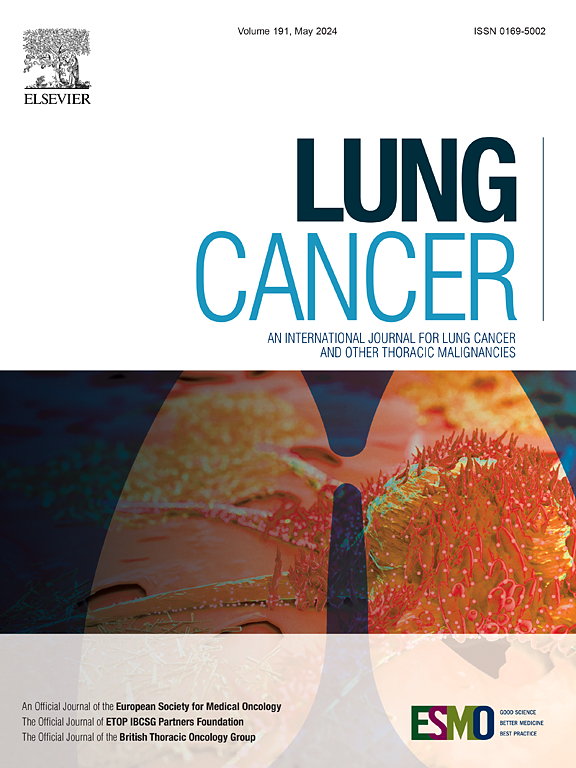中、高级别肺腺癌鳞状生长对预后的影响。
IF 4.4
2区 医学
Q1 ONCOLOGY
引用次数: 0
摘要
背景:1级肺腺癌的特征主要是鳞状生长和低于20%的高风险模式,与更高级别的肿瘤相比,其生存率较高。然而,在中高级别肿瘤(2-3级)中,褪黑素成分与预后的相关性尚不清楚。我们研究了鳞状细胞生长是否影响2-3级I期肺腺癌患者的生存。方法:这项回顾性单中心研究纳入了479例连续接受2-3级和I期非黏液性肺腺癌根治性切除术的患者。用多变量cox回归评估卵黄成分和其他预测因子对生存的影响。结果:有300例(62.6%)肿瘤呈鳞状生长。lepidc阳性肿瘤患者明显年龄较大(中位年龄67比65岁,p = 0.015),不吸烟者较多(22.1%比9.9%,p = 0.001),腺泡为主的比例较高(69.0%比53.1%,p = 0.001),实体为主的肿瘤较少(7.0%比26.8%,p)结论:lepidc生长在本研究中未显示中高级别的非粘液肺腺癌的预后意义。本文章由计算机程序翻译,如有差异,请以英文原文为准。
Prognostic impact of lepidic growth in intermediate and high-grade lung adenocarcinoma
Background
Grade 1 lung adenocarcinomas, which are characterized by predominantly lepidic growth and less than 20 % high-risk patterns, have a favorable survival rate compared to higher-grade tumors. However, the prognostic relevance of lepidic components in intermediate and high-grade tumors (grades 2–3) remains unclear. We investigated whether lepidic growth impacts survival in grade 2–3 stage I lung adenocarcinomas.
Methods
479 consecutive patients who underwent curative resection for non-mucinous lung adenocarcinoma in pathologic grade 2–3 and stage I were enrolled in this retrospective, single-center study. The impact of lepidic components and other predictors on survival was assessed in multivariable cox regression.
Results
Lepidic growth was present in 300 (62.6 %) tumors. Patients with lepidic-positive tumors were significantly older (median age 67 vs. 65 years, p = 0.015), more frequently never-smokers (22.1 % vs. 9.9 %, p = 0.001), had higher proportions of acinar-predominant (69.0 % vs. 53.1 %, p = 0.001), and fewer solid-predominant tumors (7.0 % vs. 26.8 %, p < 0.001). Median follow-up was 67 months (IQR 47–92). Multivariable Cox analysis demonstrated no significant association between lepidic growth and overall or recurrence-free survival. Factors significantly affecting recurrence-free survival included age ≥ 70 years (HR 1.40, p = 0.046), stage IB (HR 1.52, p = 0.017), grade 3 tumors (HR 1.42, p = 0.040), and lymphatic invasion (HR 1.67, p = 0.011).
Conclusion
Lepidic growth did not demonstrate prognostic significance in intermediate and high-grade non-mucinous lung adenocarcinoma in this study.
求助全文
通过发布文献求助,成功后即可免费获取论文全文。
去求助
来源期刊

Lung Cancer
医学-呼吸系统
CiteScore
9.40
自引率
3.80%
发文量
407
审稿时长
25 days
期刊介绍:
Lung Cancer is an international publication covering the clinical, translational and basic science of malignancies of the lung and chest region.Original research articles, early reports, review articles, editorials and correspondence covering the prevention, epidemiology and etiology, basic biology, pathology, clinical assessment, surgery, chemotherapy, radiotherapy, combined treatment modalities, other treatment modalities and outcomes of lung cancer are welcome.
 求助内容:
求助内容: 应助结果提醒方式:
应助结果提醒方式:


